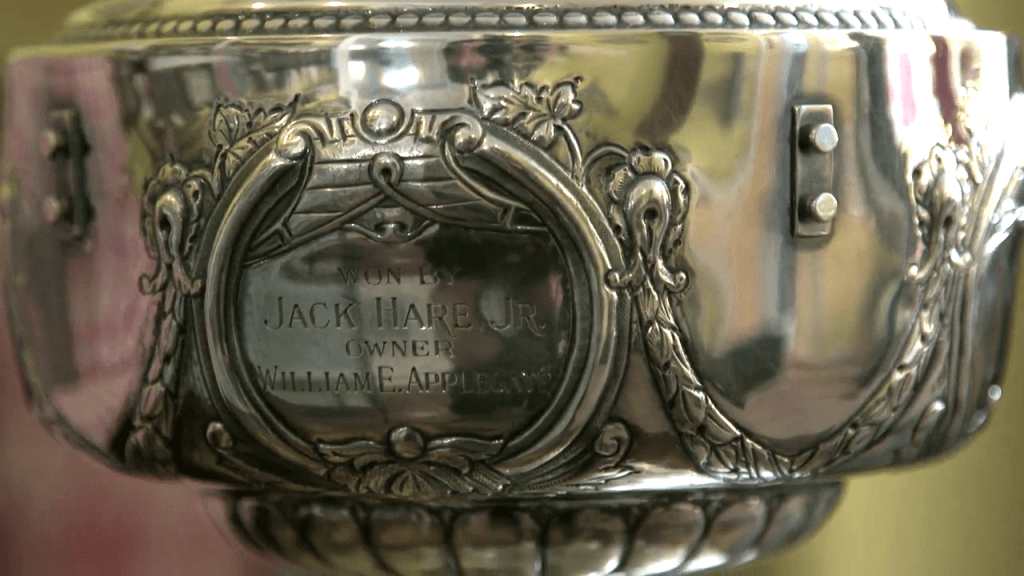
A close up of Jack Hare Jr.’s copy of the Woodlawn Vase.
The Preakness has survived bad management, the American Civil War, two World Wars, multiple political fights, a move to New York and the early 20th Century ban on gambling. The Preakness barely escaped the impact of the 1918 Spanish Flu pandemic. (Not so much in 2020.)
The country was already a bit edgy in 1918 as America had entered into the World War in Europe in April 1917. Horse racing was a welcome pastime and many looked forward to the Kentucky Derby in Louisville, Ky.
On Saturday, May 4, longshot Exterminator won the one and a quarter mile Kentucky Derby by a length over a muddy track in 2:10⅘ under jockey Willie Knapp. After the crowd witnessed the thrilling upset that day the gelding would go on to become a legend of the turf and earn the nickname ‘Old Bones’.
The Preakness was to take place at Pimlico Race Course in Baltimore, Md., eleven days later on Wednesday, May 15. The Kentucky Derby winner would not be among the contenders and Pimlico needed a strong field. Thanks to the innovative William P. Riggs, the man credited with bringing French parimutuel betting to America, the Preakness had a doubly successful 1918 edition.
Riggs, then Secretary of the Maryland Jockey Club, proposed raising the purse money of the Preakness to attract more entries. And attract he did. With a purse valued at $25,000, 26 horses put their shoes in for a spot in the 43rd Preakness. Rather than limit the field the decision was made to run in two divisions becoming the only American classic race to ever be split.
The Race: A mile and one eighth on dirt at Pimlico Race Course, weight handicap conditions
Division One:In the first division, War Cloud (GB) went off as the second favorite at post time at roughly 8/5, carrying 110 pounds (three more than any other runner), behind Lanius, who was the betting favorite at 7/5 and carried 107 pounds. Starting from post position five, War Cloud settled in third, stalking the leaders, George Starr and Flags, as they passed the stands for the first time. War Cloud then moved to the outside and passed the leaders going around the clubhouse turn, going in :48 flat for the first half mile. He widened his lead to two lengths down the backstretch, completing 3/4 mile in 1:13 flat. In the stretch, 53/1 longshot Sunny Slope challenged. War Cloud, ridden hard by jockey Johnny Loftus, held on to win by 3/4 of a length. After War Cloud and Sunny Slope, it was another ten lengths back to favorite Lanius in third, with Johren fourth.
The following year in 1919, Johnny Loftus would pilot Sir Barton to victory in not only the Preakness but all three Classics becoming the first true Triple Crown winner.
Division Two: When the horses started, Jack Hare Jr., the 9/10 favorite, rushed straight to lead and drew away by two lengths passing the stands for the first time. Rounding the club house turn he widened his lead to two and a half finishing the first half mile in :47-3/5. He continued to set a fast pace on the front end setting fractions of 1:12-3/5 and 1:39-3/5 for 3/4 and a mile. Leading comfortably by three lengths at the head of the stretch his jockey Charles Peak eased him up near the end of the race and he still won by more than two lengths. The order of finish remained almost unchanged throughout the race with The Porter finishing second six lengths ahead of Kate Brite and Trompe La Mort for third and fourth. Jack Hare Jr. carried eight pounds more than the runner-up with a winning time of 1:53.4, 0.2 seconds faster than the first division.
The purse was originally set at $25,000. It’s recorded that each division received $17,500. For the tradition of painting of the winner’s colors on the weathervane atop Pimlico’s old Members Clubhouse, each horse’s colors were featured for six months of the following year with War Cloud being first.
Neither A.K. Macomber, owner of War Cloud, nor William Applegate, owner of Jack Hare Jr., could agree who should take temporary possession of the Woodlawn Vase for the year, as was tradition, so the trophy remained in Baltimore. Each received a smaller replica of the prized trophy inscribed with their respective champion’s victory.
The Horses: Two Rivals
War Cloud (GB) (1915–1923) was a British-bred who was the first horse to compete in all three of what would become known as the U.S. Triple Crown. He was bred by Jack Barnato Joel, one of Britain’s most prominent Thoroughbred owner/breeders. War Cloud was sold as a yearling to A. K. Macomber who brought the colt to the U.S. in 1916 to prepare for a racing career. The son of Polymus (GB) out of the Persimmon (GB) mare Dreamy (GB) was trained by Walter Jennings.
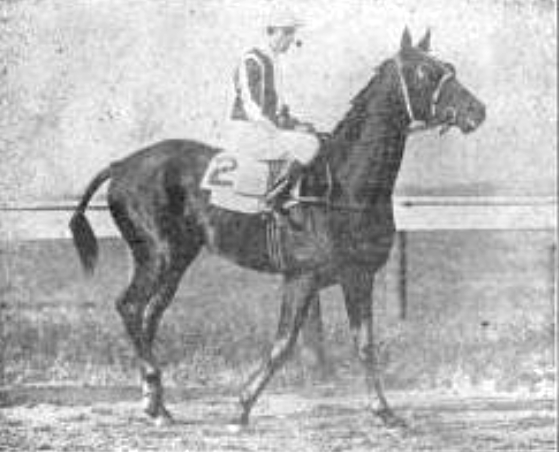
Successfully raced at age two, the Brit-bred won the Walden Stakes, the Annapolis Stakes at Laurel Park and placed second in the Nursery Stakes at Belmont Park to Jack Hare Jr.
War Cloud was the heavy favorite going into the 1918 Kentucky Derby after the U.S. two-year-old Champion Colt Sun Briar was sidelined with ringbone disease. Ridden by Johnny Loftus, War Cloud finished fourth to longshot Exterminator. In the final leg of the Triple Crown races, the Belmont Stakes, War Cloud finished second to Harry Payne Whitney’s colt, Johren.
In the Dwyer Stakes at Aqueduct Race Track in July however, War Cloud showed “brilliant speed” to defeat Jack Hare, Jr. and Johren in front of a huge crowd. He would also win the New Rochelle Handicap, the Roslyn Handicap and Scarsdale Handicap that year.
After racing successfully at age four including winning the Belmont Park Autumn Handicap and the Bayview Handicap, War Cloud was shipped to France in 1919 to race in his five-year-old season but did not perform well. He ended his racing career with a record of 28 starts with 11 wins, four seconds and three third place finishes earning $40,170 in purses.
Subsequently, War Cloud entered stud at Haras du Quesnay in France, where he stood from 1920 to 1922. In 1923, War Cloud was brought back to stand at stud at Claiborne Farm in Paris, Ky., but broke a leg soon after and was euthanized. He is buried in Claiborne’s equine cemetery.
Records kept by The Jockey Club show War Cloud as having sired 20 winners and four stakes winners from 30 named foals. His legacy was the 1927 American champion 3-year-old filly Nimba. His name appears in pedigrees almost solely through his stakes-winning daughter Bonnie Maginn, whose daughter Bonnie Beryl was a good race mare and a fine producer.
Jack Hare Jr. (1915-1929), bred by W. E. Walsh, was sired by Marathon out of the mare Moonet, a daughter of Donald A. Owned by Colonel William E. Applegate, Jack Hare Jr. was under lease to R. T. Wilson, Jr., when he won the 1917 Grab Bag Handicap. He was initially trained by R. F. Campbell but was moved to Frank Weir by August 1917, later moving to the barn of Kay Spence.
Initially campaigned as a selling plater at age two, Jack Hare Jr. was widely considered to be one of the better juveniles of the year by the end of the 1917 season. He was not a great horse, but his tenacity made him a great favorite with Eastern fans who enjoyed seeing a “pony” take down much bigger rivals in good races. A small brown horse, Jack Hare Jr. was built like “a miniature bulldog” according to the New York Times of July 12, 1918, but was speedy and game. He was a front runner by preference and was an excellent weight-carrier in spite of his small stature.
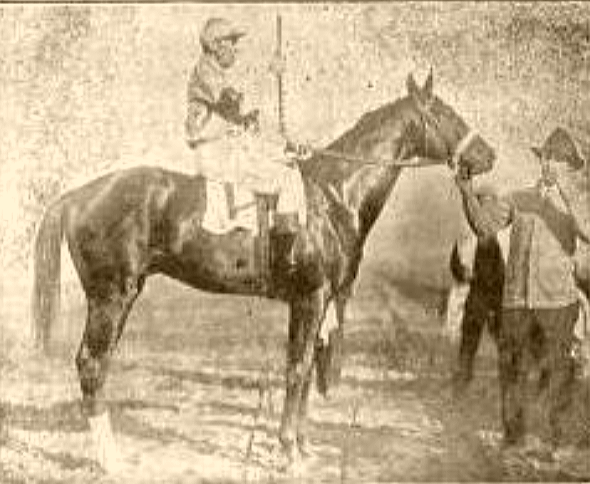
As a two-year-old, Jack Hare Jr. did very well on the race track winning a maiden race, an allowance race, the Grab Bag Stakes, Liberty Bond Handicap, Troy Selling Stakes and Babylon Handicap all in 1917. The highlight of his freshman year was his win over War Cloud in the Nursery Stakes with a winning time of 1:11-2/5 for the six furlong race.
Due to unusual circumstances, Jack Hare Jr. and War Cloud would not faceoff in the Preakness but it seems as though the best two 3-year-olds took the prize. Prizes, actually.
After his Preakness victory Jack Hare Jr. continued to race the balance of the year in 1918. He won five more stakes races that year namely the Wilmington Stakes, Woodberry Handicap, the Empire City Derby at Empire City Race Track and the Southampton Handicap at Jamaica Race Course in New York. The wily colt set a national track record in the Red Cross Handicap at Aqueduct of 1:44 2/5, 1 1/16 miles on dirt carrying 130 lbs.
He contracted pneumonia in September of his 3-year-old season and was out for the remainder. When Jack Hare Jr. returned to the track he would race substantially below his previous standard.
As a 4-year-old, the little brown colt headed south to compete in Kentucky where he won the Camp Knox Handicap, Eden City Handicap and Campbell County Handicap, the latter two both at Latonia Race Course. He would also place second in Falls City Handicap at Churchill Downs.
Jack Hare Jr. also had moderate success as an older horse winning the Booneboro Purse and Gibson Hotel Handicap at Latonia as a 5-year-old in 1920. He also placed second in the St. John Powers Memorial Handicap, a six furlong race on dirt at the Fair Grounds, and the Palace Handicap at eight furlongs at Latonia. In his 6-year-old year he was second in the Quickstep Handicap at Latonia.
The small stallion was announced as being sent to stud in April 1920 after splitting a hoof but was back in action in claiming races by mid-June. For the next several years, he continued to race with short stints at stud interspersed, finally retiring from the track for good in 1923.
According to Sires and Dams of Stakes Winners 1923-1985 (Blood-Horse), Jack Hare Jr. sired two stakes winners from 46 named foals. The Jockey Club credits Jack Hare Jr. with 29 winners. None of his progeny were of any great significance.
In November 1926, Jack Hare Jr. was moved to John Wiggins’ Military Stock Farm in Bourbon County, Ky., where he entered into the U.S. Army Remount Service. In November 1928 the stallion then went to the Tattersalls auction at Lexington, Ky. The 1918 co-Preakness champ was sold to Rush McCoy for $400. His last registered foals were born in 1929. There is no record of his death or burial.
Listen to Missie Rennie with Acacia Courtney recall her family’s 1918 Preakness victory with Jack Hare Jr., recount when the trophy was stolen and their family’s connection to Churchill Downs and the twin spires.
The U.S. Army Remount Service
A part of the Quartermaster Corps, the U.S. Army Remount Service provided horses as remounts to U.S. Army units. Evolving from both the Remount Service of the Quartermaster Corps and a general horse-breeding program under the control of the Department of Agriculture, the Remount Service began systematically breeding horses for the United States Cavalry in 1918. It remained in operation until 1948, when all animal-breeding programs returned to Department of Agriculture control.
Beginning in 1918, there was also a determined attempt to engage professional horse breeders in the Remount Service with the approval of a breeding plan for cavalry horses that combined the efforts of the Remount Service with the Bureau of Animal Industry. A 1921 issue of the Cavalry Journal contained an update from the “American Remount Association” calling for owners of “high-class registered Thoroughbreds” to add their stallions to the program. The author also mentioned a reduced-cost registry for “half-breed” Thoroughbreds.
The number of horses involved in the program remained high even into the final years of the Remount Service. As late as 1945, between 450 and 500 stallions owned by the government and over 11,000 civilian-owned mares produced 7,293 foals. Thoroughbreds predominated in the stallion rolls, although a few Morgans, Arabians, and Standardbreds were also used. The number of Arabian stallions increased greatly in 1943 with the addition of the Kellogg Arabian Ranch (renamed the Pomona Remount Depot) to the program.
In 1942, the Remount Service (then called the Remount Division) printed a breakdown of its breeding program in the Cavalry Journal. According to the article, the primary breeding horse was the Thoroughbred (17,983 mares and 688 stallions), followed by Arabians (375 mares and 16 stallions), followed by Morgans, Saddlebreds, Anglo-Arabians, and the Cleveland Bay (trailing with eight mares and one stallion). Of the foals born in 1941, 11,028 of the 11,409 reported were Thoroughbreds.
Latonia Race Course
He won at Latonia, you say? Ever heard of the place? We have!
Opened in 1883, Latonia Race Track was on Winston Avenue in Latonia (Covington) Kentucky, six miles south of Cincinnati, Ohio. The track hosted a spring-summer racing series and a second in late fall. It was once regarded as among the United States’ top sites for racing, and drew more than 100,000 visitors annually. The 1924 Kentucky Derby winner Black Gold ran at Latonia, and jockey Eddie Arcaro got his start there.
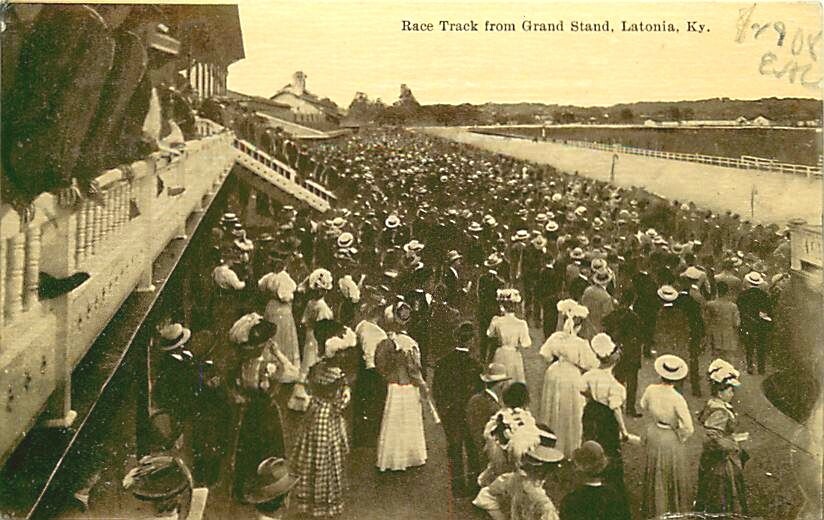
The track’s main attraction was the annual one and a half mile Latonia Derby, initially run as the “Hindoo Stakes” in honor of the great Kentucky-bred champion Hindoo. It became so popular that in 1912 a motion picture was made by Independent Motion Picture Co. titled “Winning the Latonia Derby” that featured silent film star King Baggot.
The inaugural 1883 Latonia Derby was won by the 1883 Kentucky Derby winner Leonatus. Future Kentucky Derby winners who also won the race were: Kingman (1891), Halma (1895), Ben Brush (1896), Lieut. Gibson (1900), Elwood (1904), and Sir Huon (1906). The 1918 edition was won by Harry Payne Whitney’s Belmont Stakes winning colt, Johren.
Latonia was not immune from the 1918 Spanish Flu pandemic. In fact, on October 9 it would become the first U.S. racetrack to announce postponement of its meet because of the spreading virus as reported in the Daily Racing Form.
The race course finally reopened again on November 13, two days after the end World War I on Armistice Day. Fittingly, on the 24th Exterminator won the two and a quarter mile Latonia Cup by a nose. Four days later, he won the eight and a half furlong Thanksgiving Handicap by two and a half lengths.
Latonia featured one race that was very special — the International Special. On October 11, 1924, 60,000 racing fans flocked to Latonia to witness the third and final edition of the International Special races that pitted the honored guest, French champion Epinard, against top American horses. The race featured stars of the day such as Chilhowee and Belmont Stakes winner Mad Play plus future U.S. Hall of Famers Princess Doreen and Sarazen. It was Sarazen who won the race and with it sealed Horse of the Year honors. Epinard finished second, as he had done in the previous two International Specials at Belmont Park and Aqueduct Racetrack in New York City.
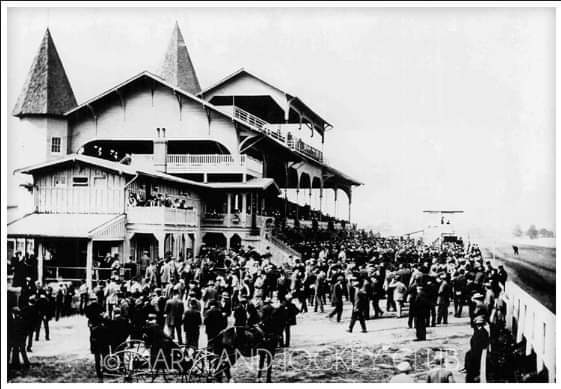
Financial difficulties during the Great Depression forced Latonia to close its doors with its last race card held on July 29, 1939. The facility was sold to Standard Oil of Ohio and dismantled during World War II. Today the property is the site of the Latonia Shopping Center and WCVG-AM radio.
In 1959, a new operation called the Latonia Race Course opened in Florence, Kentucky about 10 miles west of the original Latonia site. In 1986 that facility changed its name to Turfway Park. In 2019, Turfway was purchased by Churchill Downs Inc. (CDI).
Like Pimlico in the future, Turfway is currently being rebuilt. You can even buy one of the old blue seats on Facebook Marketplace.
Demolition of its original weathered 1959 grandstand began in April to make way for a new facility that will incorporate 1,500 slot-like historical horse racing terminals. Turfway’s new owner, CDI, has announced plans to invest $100 million in the new facility on top of the $46 million it paid for the track last year.
Set for completion in the summer of 2021, the grandstand will be demolished and rebuilt in stages to allow horses to remain in training at the facility. Though racing ended in late March, the track has allowed horsemen to remain on its backside due to a number of other track stable areas delaying spring openings because of COVID-19. Turfway had closed its winter-spring meet on March 25 three days early after running live racing Spectator-free for almost two weeks due to the Coronavirus pandemic.
For more info on Turfway Park https://www.turfway.com/home
or the Preakness https://www.preakness.com.
You can also see more about Latonia Race Course in the short film “Old Latonia: America’s Most Beautiful Race Course.”
Editor’s Note:
1918 ended with celebration at the end of World War I but in devastation and despair for the world as an estimated 9 million combatant deaths and 13 million civilian deaths occurred as a direct result of the war with the related 1918 influenza pandemic causing another 17–50 million deaths worldwide. We wish to honor the passing of all of those who died in these tragic events and extend our deepest condolences to all of those affected by the Coronavirus pandemic of 2020.
MbKalinich
Photos: War Cloud and Jack Hare Jr. Courtesy of Pedigree Thoroughbred Database.



